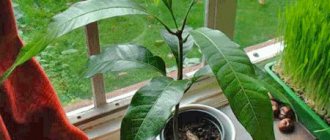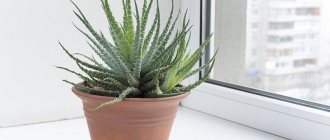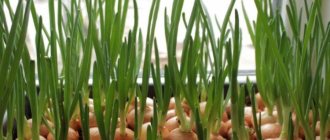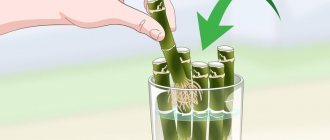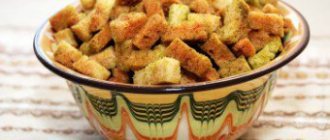Date palm at home care and maintenance
The date loves bright sunlight and needs shading only in the midday summer heat.
It is best to place small young plants on the windowsills of southern and south-eastern windows, larger and older plants - next to such windows. For uniform growth and development of the palm tree crown, it is necessary to rotate it around its axis from time to time. In the summer, the plant responds well to being kept outdoors in the garden or on the balcony, but if this is not possible, then the room should be regularly ventilated.
If the autumn-winter days did not provide enough sunlight, then in the spring the plant must be gradually accustomed to exposure to direct rays of the sun in order to avoid burns of the foliage. They do the same with a palm tree just brought from the store.
In winter, it is advisable to illuminate the date using fluorescent lamps. With insufficient lighting, palm leaves begin to stretch and droop down, losing their decorative effect.
In the spring and summer, when the date grows, it needs to be kept at a moderate temperature of 20 to 25 degrees. These tropical beauties also love higher temperatures, up to 28 degrees Celsius, but they also need high air humidity, otherwise the tips of the plant’s leaves will begin to dry out.
In winter, dates have a dormant period and need a temperature within 15-18 degrees. The Robelena date is more thermophilic and the optimal winter temperature for it is from 16 to 18 degrees Celsius.
The Canary date can spend the winter at a temperature of 8 to 10 degrees, and in adulthood with a formed trunk it tolerates a short-term decrease to 5 degrees below zero. Palm trees really don't like this kind of air stagnation. It is necessary to ensure regular ventilation of the room, while protecting the plants from drafts.
Seating in separate pots
As the date grows and develops, it becomes cramped in the pot. How to replant a date palm and when to do it?
The first transplant occurs when the leaf of the sprout has grown to 4 cm. The second transplant is carried out when the plant reaches 15 cm in height.
Since the date palm does not tolerate replanting well, it is advisable to do this only if necessary. The signal for replanting will be the obvious visibility of the roots in the drainage holes of the pot.
Young plants grow quickly and replanting is required annually. Before the procedure, moisten the soil ball well to make it easier to transfer it from the pot.
Another method of replanting a palm tree is not suitable: it has a very fragile root system. The pot is selected 3-4 cm higher than the previous one. The palm tree with the soil ball is carefully placed in the pot, and fresh soil is evenly poured into the voids of the container.
Important! Mature date palms are replanted every three years; otherwise, changing the top layer of soil is recommended.
The date palm is a spectacular ornamental plant; the only sad thing is that its propagation at home is possible only from seeds. Although in nature it reproduces well by root shoots. And yet, a green tropical tree in the house, especially during the cold winter period, significantly brightens up the anticipation of warmth and summer.
What types of dates can be grown from seeds?
Not every seed is suitable for growing at home. Of all types of dates, it is possible to grow the following types at home:
- Palmate.
Tall plant, up to 20 meters in height. With a good crown and bald trunk.
- Canary.
This is a tall plant, rising up to 15 meters. The fruits are small and orange in color.
- Robelena.
This plant has black fruits. The tree itself is about two meters in height.
- Rocky.
Like palmate, it has a bare trunk.
- Ceylonese.
This palm has short leaves.
- Curved.
This species resembles a shrub because it has several trunks.
Growing strawberries from seeds at home
Pests and diseases of date palm
Insect pests
Most often, if maintenance conditions are violated, the date palm suffers from spider mites, mealybugs and scale insects. The best way to control pests is to correct maintenance mistakes. It is best to remove insects and traces of their vital activity that destroy the plant mechanically, by wiping the leaves of the date palm with a soap-vodka solution (15 g of liquid soap, any dishwashing detergent or a teaspoon of grated solid soap dissolved in warm water, dilute in a liter of warm water and add to solution two tablespoons of vodka).
If the number does not pass, after a week the treatment of the leaves must be repeated, just do not forget to protect the soil in the pot from getting soap into it. In case of severe pest infestation, you will have to resort to treating date palm leaves with insecticides, and the best of them is actellik.
Among the diseases of the date palm, spotting is known, which disfigures the leaf blade, and pink rot, which affects not only the leaves, but sometimes also the stem, and causes them to rot. Fortunately, only weak and sick plants are susceptible to infection by these diseases, so the key to the health of your date palm is to follow the rules of caring for it. If trouble happens and the plant gets sick, treat the palm tree twice with a fungicide containing mancozeb and methyl thiophanate, observing a week interval between sessions.
Date palm dries out
Sometimes the leaves of a date palm dry out from the tips, and this is clear evidence that the air humidity in the room where the plant is located is too low, with a normal level of 50%. This is not so much, and there are more than enough ways to increase air humidity to the required value, so do not be lazy to spray and wash the leaves, otherwise the palm tree will lose its decorative effect, and it will be a great pity for wasted time and effort. Remember that the date palm dries out only if the owner is careless.
Date palm turns yellow
If you have not changed your attitude towards palm tree care in time and have not resolved the issue of supplying the plant with moisture at all levels, the next signal of an imbalance in the water balance after dry tips is yellowing leaves of the date palm. This means that you not only spray the leaves of the plant irregularly, but also forget to water it, allowing the earthen lump in the pot to dry out. If you don't have enough time to care for the plant, maybe it would be better to give your date palm to someone who has the time to take care of it?
Date palm leaves darken
When the soil in a potted date palm is chronically waterlogged, the plant's leaves gradually darken from green to brown, the trunk becomes soft, and the plant smells rotten. As soon as you notice this, stop watering the palm tree, remove it from the pot and inspect the roots: if they become dark, soft and watery, the plant has already died, but if there are still living roots among the rotten roots, then it makes sense to cut off the dead roots, sprinkling the sections with crushed charcoal, and transplant the date palm into fresh soil.
Date palm doesn't grow
As we have already written, the temperature in the room where the palm tree is located should not fall below 12 ºC in winter. At other times of the year, the temperature should not be lower than 18-20 ºC, because root growth stops at a temperature of 16-17 ºC, which means that root activity slows down and the plant is not able to absorb nutrients, which ultimately leads to cessation of growth. In addition, a imbalance occurs: the roots are able to absorb some substances, while others are not, and a deficiency of certain microelements occurs.
The reason for the date palm to stop growing can also be a too high level of soil acidity, causing a lack of manganese and iron, which is why it is so important to maintain the correct temperature regime and maintain soil acidity within a pH range below seven units. In order not to lose a tree grown from a seed, on which a lot of time and expectations have been spent, you just need to follow the rules of growing the plant, especially since there is nothing overly complicated in them, and the decorative qualities of the date palm are definitely worth the effort
In order not to lose a tree grown from a seed, on which a lot of time and expectations have been spent, you just need to follow the rules of growing the plant, especially since there is nothing overly complicated in them, and the decorative qualities of the date palm are definitely worth the effort.
Philodendron at home, description and types Fittonia - care, photos, types
After this article they usually read
Add a comment
Transfer
Dates have a fragile root system. During transplantation, it often suffers, and then the seedling dies. Therefore, it is important to wait until the plant gets stronger and the pot becomes really small for it. The palm tree is replanted no earlier than a year later, when it produces 2–3 leaves.
How to do it right?
- Lightly moisten the soil.
- Remove the plant from the old pot along with a lump of soil.
- Fill a new pot (0.5–0.7 L) about 2/3 full with palm potting soil.
- Place a lump of earth with a seedling on the bottom, and, holding it with your hand, sprinkle with the rest of the substrate.
- Water the date palm and continue to care according to the recommendations given above.
The date palm does not like “moving”, so it can be difficult to survive the transplant.
Do not cut off the bone under any circumstances. It supplies nutrients to the sprout for some time.
After transplantation, reduce watering for 2-3 weeks and after the specified time, feed the plant.
Growing a date from a seed is not as difficult as it seems at first glance. You need to follow the recommendations and be patient. In the first year or two, the plant will look like tough grass, and only after about 5 years will it transform into a real indoor palm tree.
Article rating:
How to germinate date seeds at home Link to main publication
Related publications
- Oleander care and cultivation
- Blooming flowers for the home
- Oleander at home
- Potted rose
- Ammonia for spider mites
- Flower food
- Adenium at home
- Shade-tolerant flowers for the home
- Yellow callas at home
- Mealy sage
- Morning glory sweet potato
- How to remove aphids from indoor plants
Types of date palm for indoor culture
Previously, only one species was grown at home:
The palmate date (Phoenix dactylifera) is a true date palm, the type species of the genus, common in the oases of Western Asia, the Arabian Peninsula and the Sahara deserts, as well as on the Canary Islands. The trunk is vertical, often covered with the remains of petioles of dead leaves, and grows up to 15-26 m in height, some up to 30 m.
The leaves are large, up to 6 m long, grouped in a bunch at the crown of the trunk. Flowers are wind pollinated, unisexual, in panicle inflorescences. The fruits are elongated drupes about 8 cm and up to 4 cm wide. They do not lose their taste even at 14 degrees below zero.
Date palmate
Currently, other, more decorative types are used in interior design:
Canary date (P. canariensis) - originally from the Canary Islands, but naturalized throughout the subtropical zone of the planet and now grows from the northern regions of France to the southern Chilean provinces. The tree reaches a height of 10 to 40 m. Date leaves are huge, complex-pinnate, reach 4-6 m in length and consist of 80-100 fragments on both sides of the main axis. The fruits are orange oblong berries with a large seed.
Date canarian
The Robelen date (P. roebelenii) is a popular houseplant native to Laos. It reaches 2-3 m in height, which is why among gardeners it is often called the dwarf date palm. It grows into several trunks, each of which gracefully arches from the center of the bush. The leaves are pinnately divided, grayish-green in color, pubescent below, from 60 to 120 cm long, up to 100 lobes 15-25 cm long and 1 cm wide are formed on one petiole. The flowers are small, sunny yellow, forming inflorescences 45 cm long. The fruits are drupes with a thin layer of pulp.
Date Robelena
Forest date (P. sylvestris) - also known as the silver date palm. It grows in southern Pakistan, India, Sri Lanka, Nepal, Burma and other South Asian countries. It can grow from 4 to 15 m high. The trunk is not thick in circumference - up to 40 cm. Foliage about 3 meters long forms a lush crown with a diameter of up to 10 m and can consist of 100 leaves. Inflorescences of small white flowers droop downwards, then form large inflorescences with purple-red berries, which are used to make jelly and wine. The sap from palm trunks is drunk fresh, made into punch, or boiled to produce jagged sugar.
General information about the tree
The date tree from the Palm family grows in India, Saudi Arabia, Egypt, Tunisia, the Canary Islands, Iran, and Morocco. The palm tree prefers a hot and tropical climate, the trunk grows up to 30 m, with a diameter of 80 cm, the tree lives up to 150 years. Its leaves are pinnate, curved up to 5 m in length, 12 new ones grow per year, there are no branches. Meter-long inflorescences with male and female flowers, nutritious fruits are formed from the female ovary. Fruits are eaten, fed to animals, and exported to other countries.
Diseases and pests of date palm
Violations of maintenance conditions and care rules often lead to the appearance of scale insects, mealybugs and spider mites on the plant. If the palm leaves stop growing, dry out, curl, darken and plaques appear on them, then the date is suffering from pests. It is recommended to regularly inspect the leaves and, when insects first appear on them, spray them with garlic solution or wash them with water and laundry soap. The treatment is repeated after a week.
A severely affected plant requires the use of insecticidal preparations. You can use Actellik by dissolving it in water according to the instructions.
Sick and weak trees are susceptible to diseases:
- pink rot causes rotting of leaves and stems;
- spotting disfigures the leaves.
In this case, the plant is treated with fungicides, which include methyl thiophanate and mancozeb. Processing must be carried out strictly according to the instructions that come with the drugs.
How to germinate a seed
A shoot from the seed will grow only if the fruit has not been heat treated. To try to grow a palm tree from a seed, you can use both seeds from fresh fruits and dried fruits purchased in a store, if they were dried naturally.
Soil for the plant
You can germinate the seed in ordinary soil or soil used for home flowers, but it is better to prepare a special nutrient mixture that will help speed up the growth of seedlings. To do this, you need to mix the soil with sawdust in a 1:1 ratio.
You can prepare another option, which is suitable not only for germinating seeds, but also for maintaining an adult palm tree. For it, you need to mix an equal amount of clay-turf soil, humus with leaf soil, peat and sand. You need to add a large pinch of charcoal to the resulting composition and mix the soil well so that the mass becomes homogeneous.
Preparing for germination
Before planting in the ground, seeds need to be prepared to increase their germination. To get one palm tree, it is better to take about 5-8 seeds at once, since some of them may not sprout or die as they grow. They should be freed from pulp, rinsed well and left to dry completely. After this, the planting material must be soaked in warm water for several days and left in a place with good heating. With this method of germination, water should be changed daily.
There is another way to prepare the seeds for planting. It is necessary to make 1-2 punctures on each seed with a sharp object so that water can get inside. After this, the bones need to be wrapped in several layers of soft cotton fabric or cotton wool. Planting material should be placed in a container with a small amount of water and left for 3-4 days in a warm place. It is necessary to ensure that the seeds have constant access to liquid, adding it as it evaporates. When the seeds swell a little, they can be planted.
Planting and watering
It is recommended to plant seeds in the ground in winter, since at this stage the plant will not need as much light as in subsequent periods of development. To germinate dates from seeds at home, you must proceed according to the following scheme:
- Soil is placed in a common pot for all seeds, which is watered moderately with water until moist.
- Prepared planting material is planted at a distance of at least 5 cm from each other. Seeds should be planted in the ground to a depth of 1.5 times their length.
- Immediately after planting, watering is not carried out.
- The pot with the future palm tree should be placed in a warm place with a temperature of about +30 degrees. For additional insulation, small greenhouses can be built above each bone by placing plastic glasses upside down. Remember, dates do not tolerate temperature changes; they must always be warm.
- To obtain seedlings, you need not only high temperature, but also sufficient soil moisture, so future palm trees should be watered every day without flooding them. Instead of watering the soil, you can irrigate it using a sprayer.
Seedling of seedlings
If you managed to germinate more than 1 seed, the seedlings will have to be planted in different pots. You can begin this procedure after the plants have grown at least 10-15 cm in height. If you do not do this, the dates will become crowded and they will die.
How to properly transplant violets at home
For the future palm tree, you need a high pot in which the long roots of the plant, with a diameter of at least 12 cm, will be placed. Special soil is poured into the container, which should be moistened. In order for the palm tree to grow comfortably, you need to put a good layer of drainage on the bottom of the pot. Pebbles, expanded clay or any bulk materials are suitable for this purpose.
How to plant a seed correctly
The substrate for indoor flowers from the store is suitable as a soil for planting. You can prepare it yourself: mix peat, raw sawdust and river sand in equal parts. This soil is optimal for a young plant, but in the future, during the first and subsequent transplants, the pot will need to be filled with other soil. Proportions:
- humus - 40%;
- turf land - 20%;
- leaf soil - 20%;
- sand - 20%;
- peat - 10%.
Germinating date seeds
The planting process should be carried out as follows:
- Place the cleaned and treated seeds into the soil in a strictly vertical position.
- Sprinkle a centimeter layer of the same soil on top.
- Place the container and seeds in a warm place (+22...25°C). You can directly on the heating radiator.
- Water moderately: so that the soil does not dry out, but the water does not stagnate.
Attention! With proper care, after 2-3 months a sprout will emerge from the ground - a juvenile leaf. Then it will grow into an arrow consisting of 2-3 sharp leaves.
Planting process
Even an inexperienced gardener can plant a palm tree, however, a number of important nuances should be taken into account. First of all, palm trees are somewhat different from most house flowers, which means they have their own special needs:
- Palm trees can be sown regardless of the season, however, the sprouts require a well-lit place; if there is a lack of light, they will have to be provided with artificial lighting;
- germination and duration of germination are related to the shelf life of the seed material, so it is better to sow it immediately after purchase;
- prepared seeds are placed in a light soil mixture - this can be a ready-made material for germinating seeds; in addition, gardeners often use a mixture of perlite and vermiculite, with the addition of sphagnum or a substrate made of coconut fibers; they should be moistened, but not wet; It is advisable to first disinfect the material by steaming it for 8–12 minutes in the microwave;
- There is no need to place the seeds too deep; a depth of 1–2 times the diameter of the seeds is sufficient; if you deepen them too much, they begin to rot; if the seeds are scarified, they should be planted with the cut side down;
You can take any container, but it is best to use containers made of transparent plastic with a lid - these are used to sell confectionery and baked goods; in a closed container, the seeds will not dry out, and thanks to the transparent bottom it is easier to observe the process of seedling growth; the planting should be placed in a warm place, the air temperature should be +25-+32 degrees; however, this indicator depends on the type of palm tree: for some, the normal germination temperature is +25 degrees, while for others, +30 is not enough; to eliminate the possibility of mold formation and rotting of seeds, daily ventilation should be arranged - it is enough to open the container lid for 15–20 minutes a day, ensuring free access of air; palm seeds grown at home do not need to be watered; as the substrate dries, the substrate should be carefully sprayed with a spray bottle;
Some particularly advanced “palmaholics” purchase special mini-greenhouses, with installed heating devices and a thermostat. But this pleasure is not cheap.
In summer, a container with palm seeds can be placed on the windowsill, but you just have to consider the following:
- the window sill should be warm, without drafts and constant shadow;
- The substrate and seedlings should not be exposed to direct sunlight.
If there is no place with suitable conditions, then there is a way out: future palm trees will feel good on the cabinet, where the thermometer will always show more degrees than in other areas of the room.
Rules of care
Properly caring for a date palm is no more difficult than caring for an ordinary indoor flower. It needs to be watered, given a shower, fed and replanted as it grows. The date does not tolerate drafts, keep this in mind when placing it.
Watering
Palm trees love water. It does not tolerate dried soil. However, it is also not recommended to fill it, otherwise the roots will begin to rot. It is better to water less often, but abundantly as the soil dries. If the leaves droop down and spots appear on them, it means there is insufficient watering.
Spray dates regularly; they love moisture. Once a week, arrange more serious water treatments. If possible, place the plant's pot in a bathtub, cover the soil with plastic, and rinse the trunk and leaves from the shower.
Top dressing
The date palm needs to be fed all year round. In winter, this should be done no more than once a month, and from March to September inclusive - once a week. Buy a ready-made universal mixture for palm and ornamental leaf plants. Mineral and organic fertilizers are suitable. Dilute them in water and apply to wet soil. Fertilizer should be applied a week after replanting, then the date palm will take root better.
Signs of battery shortage
- The leaves become lighter – there is not enough nitrogen in the soil. First, the leaves acquire a lighter shade, then the growth of the plant stops.
- The leaves are covered with bronze-brown spots - there is little potassium. At first the foliage will become covered with spots, then curl and dry out.
- Yellow edging on the leaves is a lack of magnesium. Feed with magnesium fertilizer, otherwise the plant will die over time.
Trimming
It is not recommended to prune the plant before 5 years of age - it may die. The top of the palm tree should also not be cut off, otherwise the growth point will be disrupted. Do not cut off damaged or yellowed foliage; let it dry out and fall off naturally.
Air humidity
Comfortable indoor air humidity for a date palm is not lower than 50 and not higher than 70%. Before the start of the heating season, move the pot away from the radiator. When the heating is turned on, cover the radiators with a wet cloth. In summer, during dry weather, spray the leaves more often with water at room temperature. This should be done at least once a week.
About caring for date palm at home:
Temperature: The optimal temperature for Date Palm in summer is 20-25 ºC, and in winter the temperature should not fall below 15-18 ºC, and some species can tolerate temperatures of 8-10 ºC. All year round, Date loves warm conditions and an influx of fresh air, but it should be protected from drafts, especially in the winter season.
Lighting: Bright lighting, but Date feels great in light shade. East and west windowsills are suitable for palm trees. Regular rotation of the palm is necessary for even development of the crown. In the summer, when the air temperature at night does not drop below 12 ºC, Date will not refuse to be kept outside in the shade of other trees. If this is not possible, the palm tree can be taken out to the balcony, while protecting it from direct sunlight.
Phoenix canariensis.
Watering: The date palm loves abundant water without drying out the earthen coma, so it must be watered abundantly and regularly. In summer, the palm tree has active growth and an increased need for water, as the soil dries out faster. In winter, with a lack of lighting and cool conditions, watering is reduced because the soil takes longer to dry out, but you should not let the soil dry out completely. To maintain moisture, the pot with the palm tree is placed on a tray filled with wet expanded clay, pebbles or moss, so that the bottom does not touch the water. Water for irrigation must be used that has settled, rain or bottled water, as hard water is detrimental to the plant. Mistakes with watering cause the greatest harm to the plant.
Humidity: The indoor palm tree loves high humidity and the higher the humidity, the better it feels. The optimal humidity threshold for it ranges from 70 to 80%. It is recommended to spray regularly; spraying in hot weather has a particularly beneficial effect on the plant. It is also necessary to give the plant a warm shower weekly to prevent spider mites. During the shower, the earthen lump should be covered with film. The best way to increase humidity in winter at temperatures below 18 ºC is to place a container of water or a humidifier next to the plant.
Phoenix roebelenii.
Fertilizers: It is necessary to fertilize from spring to autumn 2 times a month, and in winter 1 time a month with liquid fertilizers. For feeding, you can use complex fertilizers for decorative deciduous plants, as well as special fertilizers for palm trees. The palm tree responds well to fertilization through leaf spraying, which must be done once a month.
Soil: For palm trees, you can also add turf soil, humus and manure to it. It is worth considering that good soil for Date Palms should drain water quickly. Good drainage is necessary. It is recommended to add perlite and charcoal to the substrate.
Replanting: The date palm really does not like replanting, so it is replanted only when necessary using the transshipment method, replacing the drainage and adding fresh soil. When replanting, it is not recommended to bury the plant; the soil level should remain the same as before replanting. Young specimens (up to 5 years) are replanted annually, adults once every 2-3 years. Every year, if replanting is not carried out, it is necessary to change the top layer of soil. Good drainage is necessary. It is better to choose a tall pot for the palm tree, since Date has quite long roots.
Date palm pests. The plant most often gets sick not from pests, but from inattentive care. But it is worth knowing that the queen of the oasis can be affected by spider mites, mealybugs, and scale insects. For prevention, it is necessary to use a warm shower and wipe the leaves.
Phoenix dactylifera.
Caring for dates from pits at home
Earth mixture
For successful growth and development of the plant, it is necessary to select the most suitable substrate for planting. So, it must be light and also loose. The date has a rather weak and fragile root system, so you should choose the most suitable soil mixture for its cultivation. This soil can be purchased at a specialty store. But you can also do it with your own hands. To do this, you need to combine sawdust, humus, peat, and sand.
Landing
Planting a date is not at all difficult. To do this, you need to lower the prepared bone vertically into a hole made in the soil, and then sprinkle it with soil. Then the soil must be watered, but not a very large amount of water should be used. After this, the pot is moved to a fairly warm place. In order to plant a date, you do not need any special containers. You can take a pot, a large bowl, etc. After the plants have both a small leaf and a sprout, they will need to be transplanted into separate containers.
Transfer
The plant must be replanted very carefully along with the earthen lump. Try not to disturb the integrity of the root. If the root system has been damaged, then such a seedling can be thrown away, as it will not take root in a new pot.
The date palm is quite undemanding and non-capricious. This plant responds well to humidity, heat, and fertilizing. Fertilizers should be applied to the soil several times a year. Watering should be done moderately. Such a palm tree reacts negatively to both drying out and waterlogging of the earthen clod. In the summer, it is recommended that he have a shower. The date also needs direct sunlight.
Diseases and pests
Phoenix is quite unpretentious. If the date palm receives enough light, moisture and nutrients and is located in a warm place, there should be no problems with its cultivation. Most often, diseases and harmful insects affect plants weakened by improper care.
Pests
Harmful insects settling on a palm tree lead to the loss of decorativeness of its foliage, twisting and falling of the blades. Possible pests include nematodes, scale insects, mealybugs, as well as thrips and spider mites. Methods to combat them can be different and include mechanical, chemical treatment and the use of folk remedies.
Insects visible to the eye can be collected from the foliage by hand. The nematode is considered the most dangerous pest - it is especially difficult to remove. In case of damage, the date palm will have to be destroyed along with the soil, sometimes the pot will be thrown out along with it. One diseased plant can quickly infect neighboring ones.
Before using chemical treatments, they most often try to get rid of pests using household products. Among the most famous:
- A mixture of soap and vodka. About 15 g of liquid soap or 1 tsp. planed laundry soap is diluted in a liter of water. Add 2 tbsp to the solution. l of vodka and treat palm foliage weekly, repeating the procedure several times.
- Tobacco infusion. 40 g of tobacco must be poured into 1 liter of water. The resulting mixture is infused for two days, then another liter of water is poured into it again. The foliage is treated with the diluted infusion.
- Garlic extract. Approximately 4 garlic heads are kept in a liter of water for about 5 days. 6 g of the resulting mixture (1 cap from a plastic bottle) is poured into a liter of water and the foliage is sprayed with the solution.
After such treatment, the foliage is thoroughly washed with water and then allowed to dry - for this the plant must be in a warm place.
If traditional methods do not bring the desired result, you should use commercial insecticides. These include Fitoverm, Actellik, Pyrethrum and many other brands. The selected drug is diluted according to the instructions. Most often the proportion is 2 g per 1 liter of water. Before completely treating the palm tree, it is necessary to carry out a test treatment. To do this, you need to apply the drug solution to just one leaf of the plant and wait a day. If nothing happened to the date, it means that it tolerated the impact well, and the entire green part can be processed. But before complete treatment, it is necessary to cover the soil in the pot so that the insect repellent does not get into the substrate.
Diseases
Sometimes the date palm can be affected by fungal diseases. These include pink rot and gray spotting. The reason for their development is usually insufficient drainage, unsuitable soil or the presence of pests. They can be cured using fungicidal drugs. For dates, it is better to choose products that do not contain copper. They should be used systematically until the plant recovers, but do this no more than once a week.
If you care for the date properly, it will practically not get sick.
Date palm care
Where to place
Although a mature date palm can grow to a huge (by home standards) size, it grows very slowly. Therefore, the place you choose for her will stick with her for a long time. When choosing a location, you must take into account that this palm tree is a very light-loving plant and does not tolerate stagnant air. In the summer, it does not make any special demands on the air temperature and can easily tolerate daily changes. While the plant is small and quite transportable, take it out into the fresh air in the summer. If the palm tree has already reached an age when this is difficult to do, be sure to provide it with a flow of fresh air. In winter, it is desirable for the date palm to be kept cooler (recommended +10-15 degrees). In the first years of the plant’s life, a window sill, where the temperature in winter is lower than indoors, is quite suitable for placement. In order for the palm tree to grow evenly, your intervention will be required. The leaves of the plant will inevitably be drawn towards the light source, so it must be rotated periodically. This is especially true when new leaves appear.
Watering and air humidity
In warm weather, the date palm should be watered abundantly and regularly. Avoid letting the soil dry out and water as soon as the top layer of soil dries out.
Important! If the soil is allowed to dry out, the leaves of the date palm droop, and even after watering is resumed, they do not restore their original position!
But at the same time, you can’t flood the plant. Stagnant water and cool air (even in summer) can cause considerable harm. Drain the water from the pan 20-30 minutes after watering. The leaves of the plant react to flooding first. Characteristic brown spots appear on them. When they first appear, you should immediately reduce watering. But if the whole plant begins to darken at once, then immediately replant it in fresh soil, the roots have begun to rot! During transplantation, be sure to inspect the roots and remove rotten ones. In winter, watering is reduced, but it depends on the temperature. The lower it is, the less often you water and vice versa. But you can’t completely stop watering in winter.
It is believed that air humidity is not important for the date palm. This is not true. Dry air causes leaf tips to dry out. Therefore, on hot, dry days, be sure to spray it. The same should be done in winter if you were unable to keep the palm tree cool and it grows at normal room temperature. Water for watering and spraying date palms must be settled and not lower than room temperature. At the same time, it is highly desirable that it be soft. It is ideal to use melt and rain water, but you can soften it at home (read how).
Top dressing
For date palms, liquid organic fertilizer is best. I do not advise beginning flower growers to experiment with preparation, but to buy ready-made fertilizer. During the period of active development, the plant is fed three times a month. Additional monthly feeding with a solution of potassium nitrate (one gram per liter of water) also gives good results. In winter, feeding does not stop, but is reduced to once a month.
Transfer
As I already noted, the date grows very slowly, so it is considered young for quite a long time, until about 5 years of age. It is transplanted annually before reaching this age. Afterwards, the palm tree is replanted only when the need arises. Most often this is necessary when the plant’s pot becomes small. For very large plants, it is practiced to only replace the top layer of soil. Moreover, if the roots protrude excessively onto the surface of the earth, then they too are cut off (a layer of 5 to 10 centimeters). If you do not want to use purchased soil, you can make it yourself by mixing turf soil, humus, compost and sand in equal parts. To avoid stagnant water, ensure good drainage.
How to grow a date palm from a seed?
For planting, you will need seeds freshly extracted from ripe fruits. Stones from store-bought dates are quite suitable. The main thing is that they are healthy, not damaged by insects or mold, and do not have time to dry out, otherwise the likelihood of getting seedlings is sharply reduced:
- Before growing a palm tree from a date seed, the seeds are immersed in clean, warm water for 24–48 hours. During this time, the liquid is changed several times. The procedure will help free the seeds from any remaining pulp, which will prevent the seeds from becoming moldy and will speed up the appearance of sprouts.
- Planting is carried out in a ready-made substrate for palm trees or a mixture of sand and peat. The soil is moderately moistened and the container is kept warm. Over the next 2–3 weeks, caring for the palm tree at home consists of regular but very careful watering and ventilation.
- The emerging date palm sprouts are extremely sensitive to waterlogging, so when grown in a greenhouse, they are regularly ventilated and the resulting condensation is removed.
Before the seeds are immersed in the soil, it is sometimes recommended to carefully scratch them to facilitate germination. It is much healthier and safer to germinate them in moist vermiculite. Place the container with the seeds in a warm place and make sure that the substrate does not become completely dry. In this case, after 10–14 days, as soon as the gardener notices the first roots, the seeds are transferred to the soil and the pots are placed in a warm, well-lit place.
